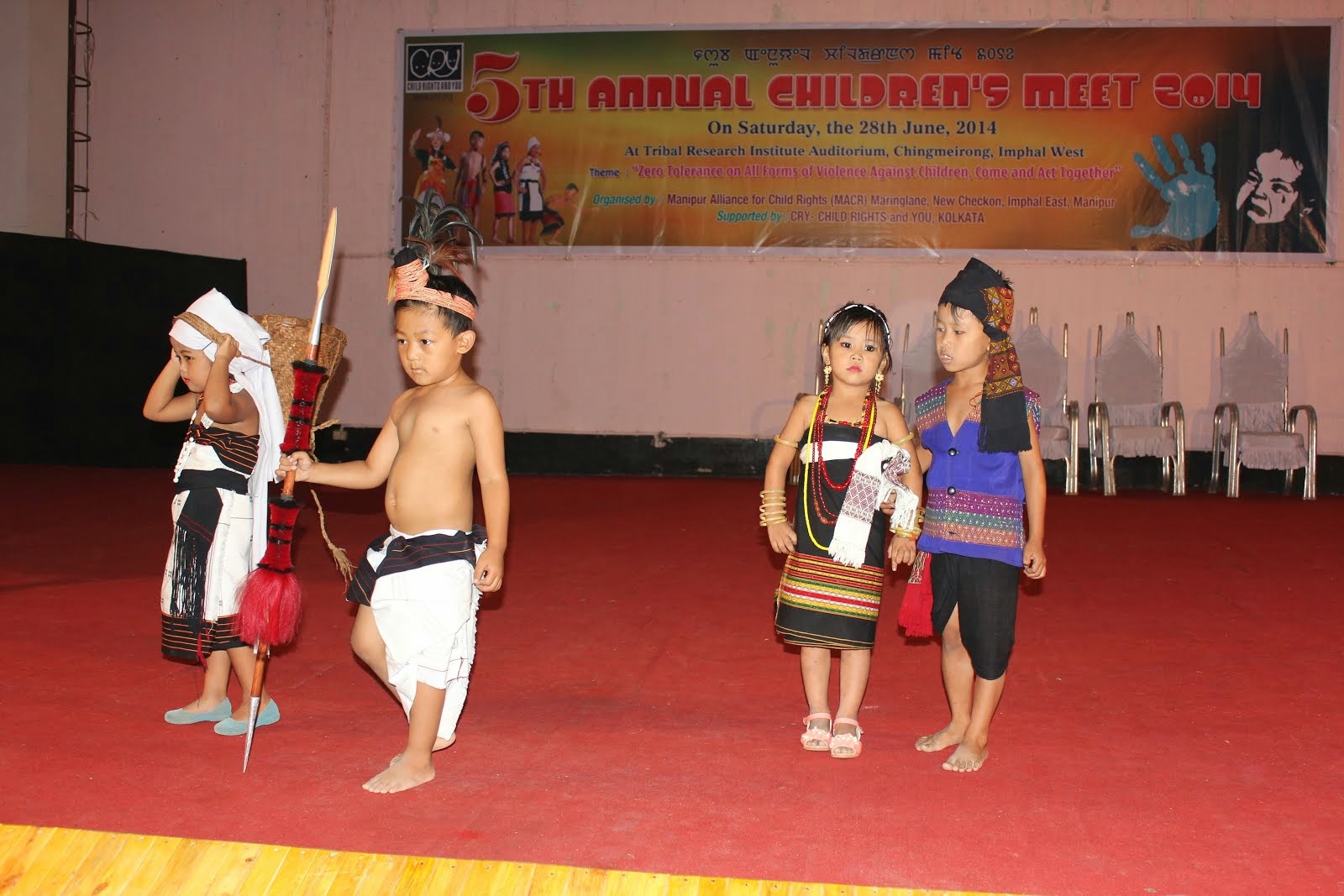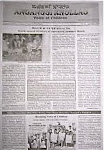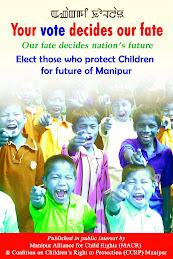Imphal Free Press
By Keisam Pradipkumar
Yet another very shameful crime against the body and soul of an innocent child - “Trafficking in children,” strikes back in Manipur, robbing the childhood from a child. Thus making of “A child without childhood” starts off. The horrendous crime, targeting the Manipuri children is on a recurrently incremental scale. Around 200 cases of child trafficking have been reported during 2007 to February, 2010. However, this figure represents only the rescued cases. Above and beyond, local victims of the other forms of human trafficking are also yet to be discovered. Unquestionably the above data is only the tip of the iceberg as the large enough portion of the iceberg is still inside the water. So far our children, who were incarcerated in illegal children homes in Chennai and other south Indian cities without enough food, good cloths and education, were tracked down and rescued. Children narrated that they were subjected to physical and sexual harassments.
The ordeal of the children could have been lengthened for an unlimited time, if the Child Welfare Committee and other agencies of Tamil Nadu state did not locate and rescue them. Prior to it in October, 2008, five Tamenglong girls, who were rescued from Malaysia, narrated their nightmarish experiences suffered in Malaysia and Singapore under the game plan of Ricky Ho, who masterminded an international human trafficking network. The rescued girls reported that hundreds of Manipuri girls were serving like them in Singapore and being fooled by agents of Ricky Ho. Those girls were reportedly forced into prostitution. Tragedy is that, all the sporadic fuss over the scandalous incidents got lost in the mists of time, as if nothing was happened, till a next similar incident is exposed in media, that seemed to be a commonality of these human trafficking incidents. Astoundingly enough, not a single culprit has ever been awarded any exemplary punishment for the offence he or she had committed.
In the recent case of rescuing of 19 children from Chennai, two local agents from Manipur who lured the parents with false promises of giving free education were released on bail in Tamil Nadu. Any further legal action against the culprits in the home state, either from the parents’ side or police is not visible till date. In such a situation, police used to disentangle themselves saying no complaint is being lodged to them. However, past experience recounts something else, as many police stations would be reluctant to register FIR against the accused persons, but end up noting down only in diary, which does not have much legal implications. In several occasions, culprits got off scot-free and managed to get easy bail. They are much ahead of time, who take advantages of loopholes of the legislations enacted for combating human trafficking.
It is duly stated that 40% of India’s Police officers are unaware of child trafficking problem and for that mater, Manipur police would not be an exception. When police officers are to blame the parents for not complaining in time, magistrates take their turn against the police for not appropriately framing the charged sheets against the culprits under relevant legislations, that fault of police, magistrates defended, compelled them to grant bails to the traffickers. Such kind of sloppy tactics of the stake holders in the criminal justice system only offer escaping routes to the culprits. Thus many culprits still continue to engage in human trafficking, the 3rd largest trade next to drug and arms trafficking, that generates upto US $8 billion every year. Interestingly, this time too, Minister of social welfare besides the concerned commissioner and director of the state, forgot to announce any short of enquiry to book the culprits, except few public messages.
Another commonality of parents of the trafficked children would be – their economically poor condition coupled with relatively low awareness level on human trafficking issues. They had a cherished dream of sending their kids in good schools, however due to their impoverished economy they failed to pay the private school’s fees and related expenses, which they found too expensive to bear. Either they wouldn’t like to send their kids to government schools which are virtually paralyzed. In such a compelling circumstance, their minds could be easily maneuvered by the trafficking agents who offered promises of “free education, free shelter and food for their children”. We know how precarious is the condition of government primary schools, even mid day meal could not attract poor children. Surva Siksha Aviyan in the state got started with bombs only to end with peashooters; it has been sarcastically paraphrased now as “Sarvanash Sikhsha Aviyan”.
Government has announced that The Right to Education Act becomes legal from 1 April, 2010. Could the free and compulsory education for the children under 14 years be reached to the millions of children, which makes 40 percent of the total population of the country? If the budgetary size on education and health are to rely as an indicator, then the answer would be arguably negative. India allocates around 3 percent for education and around 1 percent for health while few developed countries in the world like the USA, UK and France spend around 6-7 percent of their national budgets for public education and health. How can we imagine a successful implementation of free and compulsory education, if government could not invest a reasonable budgetary allocation on education?
In India, the government spends Rs.9000 annually on a student reading in a Navovidyalaya, at the same time it spends only Rs. 846 on a child in a government run village school. How can the state ensure equity in education, if there is a sharp disparity in the government run educational institutions, leaving aside the private run institutions? India’s high sounding propaganda of its continuous GDP growth, is still miles away to give its astonishing impact in Manipur, at least if we take the stock of pathetic conditions of government schools in rural and hill areas. It is very doubtful that free and compulsory education would be much successful in the state, unless the culture of corruption, siphoning of funds, mismanagement and ill-governance are stopped. We witnessed, in Manipur the high corruption in public offices dominates over other issues including insurgency, AFSPA and HIV/AIDS. Culture of Armed violence (not armed revolution), fake encounter are the byproducts of dehumanization process and political corruptions.
Since, child trafficking is only one of the manifestations of certain larger issues such as poverty, failure of government education, unemployment, hostile social environment or globalization. We need a holistic outlook to understand the dynamics of push and pull factors around the trafficking issues. Communitization of education for revamping the failed government schools should be prioritized in Leikais and Khungangs of Ching and Tam, besides parenting education, economic upliftment and mass sensitization on human trafficking. Trafficked children need further rehabilitation and restorative process to prevent possible re-trafficking cases as well as to regain normalcy. Hope, the state authority shall definitely provide the rescued children bringing back to Imphal from Chennai and Kanyakumaree, with the facilities of trauma counselling, medical care, economic and educational support, besides taking up legal actions against the culprits, in the best interest of the children.



















No comments:
Post a Comment